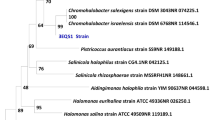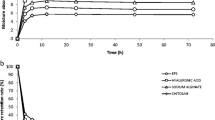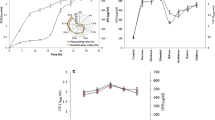Abstract
This study deals with the characterization of exopolysaccharides (EPS) synthesized by a halophilic bacterium Salibacterium halochares STm recently isolated from saline soil in Cuatro Ciénegas Basin, Coahuila Mexico. S. halochares exhibited an EPS production of 17.38 g/L (at 72 h), using a modified ATCC 2185 culture medium (with yeast extract at 6 g/L and NaCl at 120 g/L). Chemical characterization of the EPS revealed a composition of total sugars, protein, and uronic acids contents of 83.83%, 1.59% and 2.09% (w/w), respectively. The purified EPS showed a molecular weight of 1283 kDa. Rheological studies of the EPS aqueous solutions indicated a non-Newtonian rheological behaviour which was reliably modeled by the Cross equation. The EPS showed high emulsification indexes (EI) against diverse non-polar substances and formed microemulsions with negative high \(\zeta\)-potential values (up to − 46 mV). The viscoelastic behaviour data indicated the high stability of hexane–water (1:1 ratio) emulsions stabilized with EPS. The EPS retained its EI at harsh conditions of pH (4, 6.5, 7 and 12), NaCl (0, 2.0 and 4.0 M) and thermal incubation (up to 40 °C, 60 min). This is the first time that a Salibacterium genus member is reported as an EPS-producer. These results reveal the discovery of a novel polysaccharide with great potential for industrial applications, such as emulsion stabilizer, viscosity modifier and thickener.
Graphical Abstract







Similar content being viewed by others
References
Obruca S, Sedlacek P, Koller M (2021) The underexplored role of diverse stress factors in microbial biopolymer synthesis. Bioresour Technol. https://doi.org/10.1016/j.biortech.2021.124767
Koller M (2017) Production of polyhydroxyalkanoate (PHA) biopolyesters by extremophiles. MOJ Polym. Sci. 1(2):1–19
Donot F, Fontana A, Baccou JC, Schorr-Galindo S (2012) Microbial exopolysaccharides: main examples of synthesis, excretion, genetics and extraction. Carbohydr. Polym. 87(2):951–962
McClements DJ, Gumus CE (2016) Natural emulsifiers—biosurfactants, phospholipids, biopolymers, and colloidal particles: molecular and physicochemical basis of functional performance. Adv. Colloid Interface Sci. 234(2016):3–26
Koller M, Chiellini E, Braunegg G (2015) Study on the production and re-use of poly(3-hydroxybutyrate-co-3-hydroxyvalerate) and extracellular polysaccharide by the archaeon Haloferax mediterranei strain DSM 1411. Chem. Biochem. Eng. Q. 29(2):87–98
Sun ML, Liu SB, Qiao LP et al (2014) A novel exopolysaccharide from deep-sea bacterium Zunongwangia profunda SM-A87: low-cost fermentation, moisture retention, and antioxidant activities. Appl. Microbiol. Biotechnol. 98(2014):7437–7445
Ventosa A, Nieto JJ (1995) Biotechnological applications and potentialities of halophilic microorganisms. World J. Microbiol. Biotechnol. 11(1):85–94
Oren Ventosa A (2016) International committee on systematics of prokaryotes subcommittee on the taxonomy of halobacteriaceae and subcommittee on the taxonomy of Halomonadaceae. Minutes of the joint open meeting, 23 may 2016, San Juan, Puerto Rico. Int. J. Syst. Evol. Microbiol. 66:4291–4295
López-Ortega MA, Chavarría-Hernández N, López-Cuellar MR, Rodríguez-Hernández AI (2021) A review of extracellular polysaccharides from extreme niches: an emerging natural source for the biotechnology. From the adverse to diverse! Int. J. Biol. Macromol. 177:559–577
Gutierrez T, Morris G, Ellis D, Mulloy B, Aitken MD (2020) Production and characterization of a marine Halomonas surface-active exopolymer. Appl. Microbiol. Biotechnol. 104(3):1063–1076
Biswas J, Mandal S, Paul AK (2015) Production, partial purification and some bio-physicochemical properties of EPS produced by Halomonas xianhensis SUR308 isolated from a saltern environment. J. Biol. Act. Prod. Nat. 5:108–119
Squillaci G, Finamore R, Diana P et al (2016) Production and properties of an exopolysaccharide synthesized by the extreme halophilic archaeon Haloterrigena turkmenica. Appl. Microbiol. Biotechnol. 100(2):613–623
Lü Y, Lu H, Wang S et al (2017) An acidic exopolysaccharide from Haloarcula hispanica ATCC33960 and two genes responsible for its synthesis. Archaea. https://doi.org/10.1155/2017/5842958
Delgado-García M, Contreras-Ramos SM, Rodríguez JA et al (2018) Isolation of halophilic bacteria associated with saline and alkaline-sodic soils by culture dependent approach. Heliyon 4(11):1–18.
López-Ortega MA, Rodríguez-Hernández AI, Camacho-Ruíz RM et al (2020) Physicochemical characterization and emulsifying properties of a novel exopolysaccharide produced by haloarchaeon Haloferax mucosum. Int. J. Biol. Macromol. 142, 152–162
Marchesi JR, Sato T, Weightman AJ et al (1998) Design and evaluation of useful bacterium-specific PCR primers that amplify genes coding for bacterial 16S rRNA. Appl. Environ. Microbiol. 64(2):795–799
Dubois M, Gilles KA, Hamilton JK et al (1956) Colorimetric method for determination of sugars and related substances. Anal. Chem. 28(3):350–356
Song JM, Im JH, Kang JH et al (2009) A simple method for hyaluronic acid quantification in culture broth. Carbohydr. Polym. 78(3):633–634
Bradford MM (1976) A rapid and sensitive method for the quantitation of microgram quantities of protein utilizing the principle of protein-dye binding. Anal. Biochem. 72(1-2): 248–254
Rao MA (2014) Rheology of fluid, semisolid, and solid foods: Principles and applications, 3rd edn. Springer Science & Business Media, Heidelberg
Colin VL, Pereira CE, Villegas LB et al (2013) Production and partial characterization of bioemulsifier from a chromium-resistant actinobacteria. Chemosphere 90(4):1372–1378
Torres O, Murray B, Sarkar A (2017) Design of novel emulsion microgel particles of tuneable size. Food Hydrocoll. 71:47–59
Pappa A, Sánchez-Poroo C, Lazoura P et al (2010) Bacillus halochares sp. nov., a halophilic bacterium isolated from a solar saltern. Int. J. Syst. Evol. Microbiol. 60(6):1432–1436
Reddy SV, Thirumala M, Sasikala C et al (2015) Salibacterium halotolerans gen. nov., sp. nov., a bacterium isolated from a salt pan, reclassification of Bacillus qingdaonensis as Salibacterium qingdaonense comb. nov. and Bacillus halochares as Salibacterium halochares comb. nov. Int. J. Syst. Evol. Microbiol. 65((Pt_11)):4270–4275
Coleri C, Basar K, Beste P et al (2017) Determination of the biofilm production capacities and characteristics of members belonging to Bacillaceae family, World J. Microbiol. Biotechnol. 33:1–13.
Souza V, Moreno-Letelier A, Travisano M et al (2018) The lost world of Cuatro Ciénegas Basin, a relictual bacterial niche in a desert oasis. Elife 7:e38278
Gan L, Li X, Wang H, Peng B, Tian Y (2019) Structural characterization and functional evaluation of a novel exopolysaccharide from the moderate halophile Gracilibacillus sp. SCU50. Int. J. Biol. Macromol. 154:1140–1148
Radchenkova N, Vassilev S, Martinov M et al (2014) Optimization of the aeration and agitation speed of Aeribacillus palidus 418 exopolysaccharide production and the emulsifying properties of the product. Process Biochem. 49(4):576–582
Poli A, Kazak H, Gürleyendağ B et al (2009) High level synthesis of levan by a novel Halomonas species growing on defined media. Carbohydr. Polym. 78(4):651–657
Torres S, Martínez MA, Pandey A et al (2009) An organic-solvent-tolerant esterase from thermophilic Bacillus licheniformis S-86. Bioresour. Technol. 100(2):896–902
Litzner BR, Caton TM, Schneegurt MA (2006) Carbon substrate utilization, antibiotic sensitivity, and numerical taxonomy of bacterial isolates from the Great Salt Plains of Oklahoma, Arch. Microbiol. 185:286–296.
Wang L, Gu Y, Zheng X et al (2021) Analysis of physicochemical properties of exopolysaccharide from Leuconostoc mesenteroides strain XR1 and its application in fermented milk. Lwt 146:111449
Pei F, Ma Y, Chen X et al (2020) Purification and structural characterization and antioxidant activity of levan from Bacillus megaterium PFY-147, Int. J. Biol. Macromol. 161:1181–1188
Gomaa M, Yousef N (2020) Optimization of production and intrinsic viscosity of an exopolysaccharide from a high yielding Virgibacillus salarius BM02: study of its potential antioxidant, emulsifying properties and application in the mixotrophic cultivation of Spirulina platensis. Int. J. Biol. Macromol. 149:552–561
Caccamo MT, Zammuto V, Gugliandolo C et al (2018) Thermal restraint of a bacterial exopolysaccharide of shallow vent origin. Int. J. Biol. Macromol. 114: 649–655
Vidhyalakshmi R, Valli NC, Kumar GN et al (2016) Bacillus circulans exopolysaccharide: production, characterization and bioactivities. Int. J. Biol. Macromol. 87:405–414
Malick A, Khodaei N, Benkerroum N, Karboune S (2017) Production of exopolysaccharides by selected Bacillus strains: Optimization of media composition to maximize the yield and structural characterization, Int. J. Biol. Macromol. 102:539–549.
BD, Gojgic-Cvijovic GD, Jakovljevic DM et al (2015) High levan production by Bacillus licheniformis NS032 using ammonium chloride as the sole nitrogen source, Appl Biochem Biotechnol. 175:3068–3083
Zhu W, Wang Y, Yan F et al (2018) Physical and chemical properties, percutaneous absorption-promoting effects of exopolysaccharide produced by Bacillus atrophaeus WYZ strain, Carbohydr. Polym. 192:52–60
Han Y, Liu E, Liu L et al (2015) Rheological, emulsifying and thermostability properties of two exopolysaccharides produced by Bacillus amyloliquefaciens LPL061. Carbohydr. Polym. 115:230–237
Rütering M, Schmid J, Rühmann B et al (2016) Controlled production of polysaccharides-exploiting nutrient supply for levan and heteropolysaccharide formation in Paenibacillus sp. Carbohydr. Polym. 148, 326–334
Capanema NS, Mansur AA, de Jesus AC et al (2018) Superabsorbent crosslinked carboxymethyl cellulose-PEG hydrogels for potential wound dressing applications, Int. J. Biol. Macromol. 106:1218–1234.
Kumar CG, Joo HS, Choi JW et al (2004) Purification and characterization of an extracellular polysaccharide from haloalkalophilic Bacillus sp. I-450. Enzyme Microb. Technol. 34(7):673–681
Guerrero P, Kerry JP, de la Caba K (2014) FTIR characterization of protein-polysaccharide interactions in extruded blends, Carbohydr. Polym. 111:598–605.
Pradhan AK, Pradhan N, Mall G et al (2013) Application of lipopeptide biosurfactant isolated from a halophile: Bacillus tequilensis ch for inhibition of biofilm, Appl. Biochem. Biotechnol. 171:1362–1375
Čopíková J, Barros AS, Šmídovác I et al (2006) Influence of hydration of food additive polysaccharides on FT-IR spectra distinction, Carbohydr. Polym. 63:355–359
Mitić Z, Nikolić GS, Cakić M et al (2009) FTIR spectroscopic characterization of Cu(II) coordination compounds with exopolysaccharide pullulan and its derivatives, J. Mol. Struct. 924–926:264–273
Nejatzadeh-Barandozi F, Enferadi ST (2012) FT-IR study of the polysaccharides isolated from the skin juice, gel juice, and flower of aloe vera tissues affected by fertilizer treatment. Org. Med. Chem. Lett. 2(1):1–9
Bosh MT, Robert M, Mercadé M et al (1988) Surface active compounds on microbial cultures. Tensides, Surfactants, Deterg. 25(4):208–211
Dickinson E (2003) Hydrocolloids at interfaces and the influence on the properties of dispersed systems. Food Hydrocoll. 17(1): 25
Gorret N, Maubois JL, Engasser JM et al (2001) Study of the effects of temperature, pH and yeast extract on growth and exopolysaccharides production by Propionibacterium acidi-propionici on milk microfiltrate using a response surface methodology. J. Appl. Microbiol. 90:788–796
Bai L, Liu F, Xu X et al (2017) Impact of polysaccharide molecular characteristics on viscosity enhancement and depletion flocculation. J. Food Eng. 207:35–45
Mathivanan K, Chandirika JU, Vinothkanna A et al (2021) Characterization and biotechnological functional activities of exopolysaccharides produced by Lysinibacillus fusiformis KMNTT–10, J. Polym. Environ. 29(6):742–1751
López-Franco YL, Córdova-Moreno RE, Goycoolea FM et al (2012) Classification and physicochemical characterization of mesquite gum (Prosopis spp.). Food Hydrocoll. 26(1):159–166
Dickinson E (2018) Hydrocolloids acting as emulsifying agents—how do they do it? Food Hydrocoll. 78:2–14
Arias S, Del Moral A, Ferrer MR et al (2003) Mauran, an exopolysaccharide produced by the halophilic bacterium Halomonas maura, with a novel composition and interesting properties for biotechnology. Extremophiles 7(4):319–326
Sutherland IW (1994) Structure-function relationships in microbial exopolysaccharides. Biotechnol. Adv. 12(2):393–448
Qian C, McClements DJ (2011) Formation of nanoemulsions stabilized by model food-grade emulsifiers using high-pressure homogenization: factors affecting particle size. Food Hydrocoll. 25:1000–1008
Tokle T, McClements DJ (2011) Physicochemical properties of lactoferrin stabilized oil-in-water emulsions: effects of pH, salt and heating. Food Hydrocoll. 25:976–982
Joye JI, McClements DJ (2014) Biopolymer-based nanoparticles and microparticles: fabrication, characterization, and application. Curr. Opin. Colloid Interface Sci. 19:417–427
Jayme ML, Dunstan DE, Gee ML (1999) Zeta potentials of gum arabic stabilised oil in water emulsions. Food Hydrocoll. 13(6):459–465
Molet-Rodríguez A, Salvia-Trujillo L, Martín-Belloso O (2018) Emulsions: key aspects of their formulation and physicochemical stability. Beverages 4:2–10
Carrión O, Delgado L, Mercade E (2015) New emulsifying and cryoprotective exopolysaccharide from Antarctic Pseudomonas sp. ID1. Carbohydr. Polym. 117:1028–1034
Acedo-Carrillo JI, Rosas-Durazo A, Herrera-Urbina R et al (2006) Zeta potential and drop growth of oil in water emulsions stabilized with mesquite gum. Carbohydr. Polym. 65(3):327–336
Leroux J, Langendorff V, Schick G et al (2003) Emulsion stabilizing properties of pectin. Food Hydrocoll. 17(4):455–462
Dickinson E (2012) Emulsion gels: the structuring of soft solids with protein-stabilized oil droplets. Food Hydrocoll. 28(1):224–241
Rezvani E, Schleining G, Taherian AR (2012) Assessment of physical and mechanical properties of orange oil-in-water beverage emulsions using response surface methodology. LWT—Food Sci. Technol. 48:82–88
Tadros T (2004) Application of rheology for assessment and prediction of the long-term physical stability of emulsions. Adv. Colloid Interface Sci. 108:227–258
García MC, Alfaro MC, Calero N, Muñoz J (2014) Influence of polysaccharides on the rheology and stabilization of α-pinene emulsions. Carbohydr. Polym. 105:177–183
Torres LG, Iturbe R, Snowden MJ, Chowdhry BZ, Leharne SA (2007) Preparation of o/w emulsions stabilized by solid particles and their characterization by oscillatory rheology. Colloids Surf. A Physicochem. Eng. Asp. 302(1–3):439–448
Valdez MA, Acedo-Carrillo JI, Rosas-Durazo A et al (2006) Small-deformation rheology of mesquite gum stabilized oil in water emulsions. Carbohydr. Polym. 64(2):205–211
Liang Y, Gillies G, Patel H, Matia-Merino L, Ye A, Golding M (2014) Physical stability, microstructure and rheology of sodium-caseinate-stabilized emulsions as influenced by protein concentration and non-adsorbing polysaccharides. Food Hydrocoll. 36:245–255
Castel V, Rubiolo AC, Carrara CR (2017) Droplet size distribution, rheological behavior and stability of corn oil emulsions stabilized by a novel hydrocolloid (Brea gum) compared with gum arabic. Food Hydrocoll. 63(2017):170–177
Bai L, Huan S, Li Z, McClements DJ (2017) Comparison of emulsifying properties of food-grade polysaccharides in oil-in-water emulsions: gum arabic, beet pectin, and corn fiber gum. Food Hydrocoll. 66:144–153
Acknowledgements
MA López-Ortega greatly appreciates the PhD scholarship by CONACyT-México [412346/258212]. Funding: Mexican agencies: CONACyT [INFRA 2014, 230138; INFRA 2015, 254437; INFRA 2016, 269805; CB-2014/239553; CB-2014/238359-Z; ACF 2021, 316558] and Red PRODEP-SEP “Diseño y Caracterización de Películas Alimentarias a base de Biopolímeros y Antimicrobianos Naturales” [2016/2017].
Author information
Authors and Affiliations
Contributions
LOMA: Conceptualization, Investigation, Methodology, Data Curation, Writing-original Draft & Editing, Visualization. RHAI: Methodology, Writing—Review & Editing, Conceptualization, Formal analysis, Visualization. CHN: Methodology, Writing—Review & Editing, Conceptualization, Funding acquisition, Formal analysis. LCMR: Methodology, Writing-review & Editing, Conceptualization, Funding acquisition, Formal analysis. GGY: Supervision, resources & Funding acquisition. CJ: Supervision, Conceptualization, Analysis data, Review & Editing. BTA: Supervision. CRRM: Supervision, Project administration & Funding acquisition.
Corresponding author
Ethics declarations
Conflict of interest
The authors declare no conflict of interest.
Additional information
Publisher’s Note
Springer Nature remains neutral with regard to jurisdictional claims in published maps and institutional affiliations.
Supplementary Information
Below is the link to the electronic supplementary material.
Rights and permissions
About this article
Cite this article
López-Ortega, M.A., Rodríguez-Hernández, A.I., Chavarría-Hernández, N. et al. “Extracellular Polysaccharide Synthesized by the Halophilic Bacterium Salibacterium halochares STm, Isolated from Gypsum Dunes: Production, Physicochemical Characterization and Emulsifying Properties”. J Polym Environ 30, 2050–2065 (2022). https://doi.org/10.1007/s10924-021-02326-9
Accepted:
Published:
Issue Date:
DOI: https://doi.org/10.1007/s10924-021-02326-9




